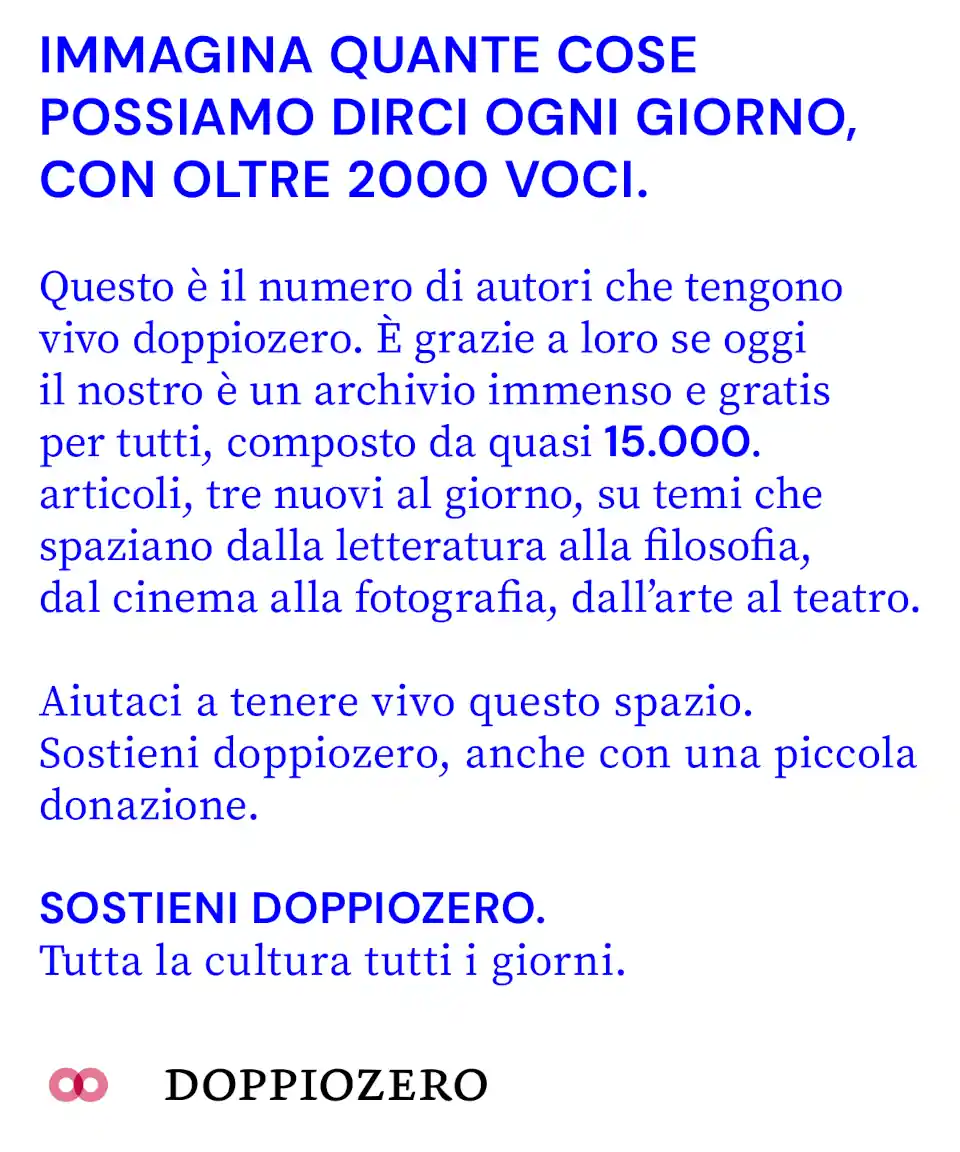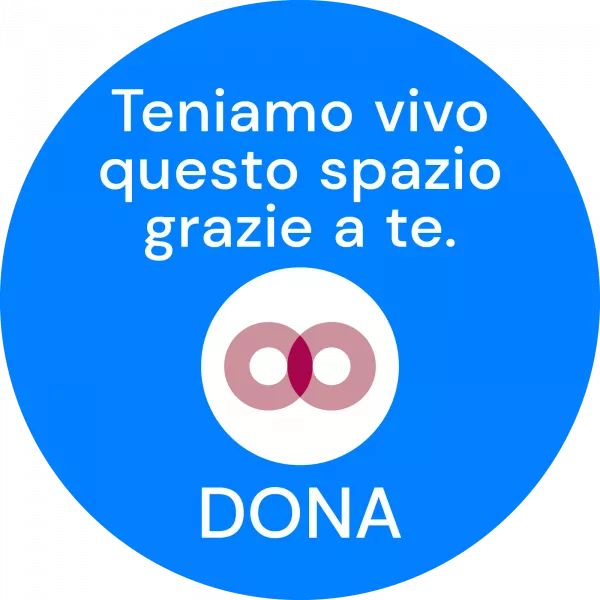
Speciale
With Kër Thiossane, Africa Is Home to Open Culture
Why Africa? For many years lettera27 has been dedicated to exploring various issues and debates around the African continent and with this new editorial column we would like to open a dialogue with cultural protagonists who deal with Africa. This will be the place to express opinions, tell their stories, stimulate the critical debate and suggest ideas to subvert multiple stereotypes surrounding this immense continent. With this new column we would like to open new perspectives: geographical, cultural, sociological. We would like the column to be a stimulus to learn, re-think, be inspired and share knowledge.
Elena Korzhenevich,
lettera27
Here the column's introduction: Why Africa?
Kër Thiossane in Wolof means “house of traditional culture.” This is the name that Momar François Sylla and Marion Louisgrand chose for the center dedicated to art and digital culture that they founded in Dakar in 2002, with the support of Fondation Langois, Montreal. Kër Thiossane aims at the democratization of multimedia technologies and digital media in general, particularly focusing on their creative dimension and emphasizing the importance of free software. Their activities are carried out in an environment that is different from that of museums and galleries.
For more than 10 years, Kër Thiossane has been promoting research on art and new technologies, investigating their effects on contemporary society through residencies, training courses, meetings and workshops. Since 2008, they have organized four Afropixel festivals within the OFF Program of the Dak’Art Biennale, proposing a critical approach to society through art and “open source” technologies. From 2010 to 2012, with the support of an ACP (African, Caribbean and Pacific) fund, they developed the spin-off twinning project “Rose de Vents Numérique” with the aim of sharing technical, cultural and artistic knowledge in Senegal, Mali, South Africa and the Caribbean. Since the 2011 World Social Forum in Dakar, Kër Thiossane has been promoting local and international projects focusing on the definition and development of “common good”, such as Remix The Commons. In 2014, they continued their research on “common good” by establishing the École des Communs in the district of Sicap Liberté. The sharing of knowledge in the school is a daily experience occurring in a collective garden and in a Fablab called “Defko Ak Niep” (“Do it together”), located in the public space. lettera27 has been a partner of Kër Thiossane since 2008. Together with Moleskine, it has supported the four editions of Afropixel since its foundation and co-created some of the events in the festival’s program: WikiAfrica Arte in 2008, Mobile A2K in 2010 (as part of Rose de Vents Numériques), the first chapter of AtWork in 2012, and capacity building and shared value networking projects in 2014.
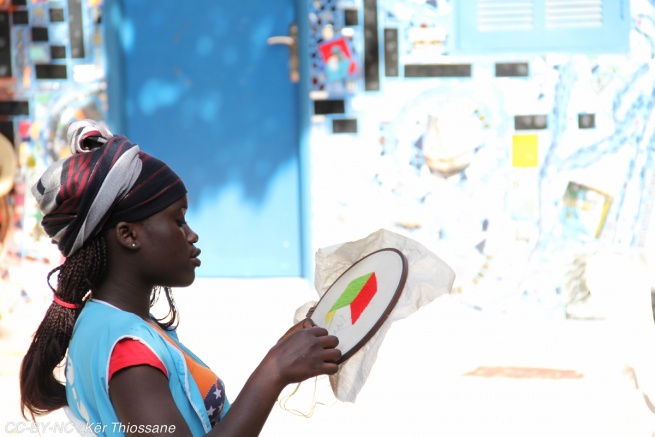
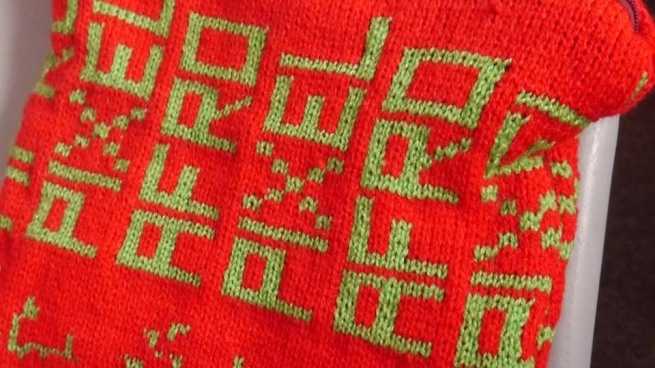 Workshop Textil Motif Remix, 2014, CC BY-NC, Courtesy Kër Thiossane
Workshop Textil Motif Remix, 2014, CC BY-NC, Courtesy Kër Thiossane
The “house of traditional culture”: the choice of associating “tradition” with multimedia technologies is quite original for a cultural center that was originally set up in Africa but has become part of an international network of institutions and festivals experimenting with technologies. It is a sort of anomaly, considering that the digital is usually associated – and not always rightfully so – with the idea of innovation, with creations able to make a change and project us into the future. So, why is tradition so important for a cultural project that makes a strenuous, almost militant effort to use technologies to act upon the local environment, the city and the neighborhood, while also establishing a dialogue with the most innovative events in the field of DIY? What has tradition to do with a project that also intends to deconstruct the most common stereotypes about Africa by means of technological and social innovation?
What makes Kër Thiossane and the work of Momar François Sylla and Marion Louisgrand a valuable example of dialogue between local and global environments is their ability to drive digital culture out of the niche to which many Western projects have relegated it, rather using it to make a true, powerful impact on society. They managed to develop high-quality and theoretically-sound projects and activities, involving artists, intellectuals, researchers and digital experts from all over the world, but – more importantly – they were able to put them together with the people of Dakar in order to bring about some change in the daily lives of the residents: not only young makers, fabbers and other technology experts, but also common people, inhabitants of the neighborhood, old people, young aspiring social entrepreneurs, children and old craftsmen. Such a process can only be triggered by pointing to the future while holding onto the past, by drawing on the shared identity of local communities and becoming deep-rooted in the places from which change can be generated.
Kër Thiossane is thus the “house of traditional culture” because it did not surrender to the search of the new at all costs, but brought some typical expressions of cultural and technological innovation – such as DIY, open culture and sharing – into a cultural environment, that of Senegal, which puts great emphasis on the value of “doing things together” and “common good”. A few years ago, the Afropixel Festival hosted one of the workshops organized by AtWork, a project conceived by lettera27. During the workshop, participants created their works on Moleskine notebooks and then produced a series of silk-screen T-shirts inspired by them. On one of the T-shirts there was the writing “NIOO KO BOKK”, a traditional Senegalese expression meaning “Thank you for sharing with me”, which once again confirms how much we can learn from Africa about the sharing of knowledge and open culture. Kër Thiossane has been cultivating this immaterial wealth for more than 10 years, starting with Africa and moving on to the rest of the world.
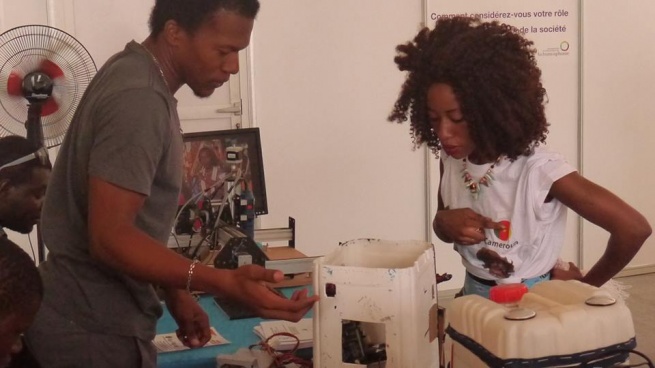 Workshop 'Jerry Cane construction D'Ordinateur', Afropixel #4, 2014, CC BY-NC, Courtesy Kër Thiossane
Workshop 'Jerry Cane construction D'Ordinateur', Afropixel #4, 2014, CC BY-NC, Courtesy Kër Thiossane
Lettera27: What is the idea behind Kër Thiossane? What motivates you to wake up every morning and go to work? What kind of change would you like to make through Kër Thiossane’s projects?
Marion Louisgrand: We want to create a sort of workshop where art and culture question society and become a vehicle for social change. We believe that, regardless of the context, art should not be disconnected from everyday life, and culture should be accessible to all. Everyone has a creative potential that must be taken care of and nurtured, especially young people. Art is an excellent tool to raise awareness, to make people think and react to environmental and social issues. We truly believe that art can change our way of thinking and seeing the world. Artists open up new pathways in our life.
What motivates me every morning is the sense of freedom that I feel whenever I work on a project that I love, in which I believe, and that sometimes seems utopian but is definitely useful. Although culture is not adequately recognized and supported in Senegal, I have the feeling that the activities that Kër Thiossane has been carrying out for the last 10 years can contribute to a new reflection on social change and development, which starts with Africa but becomes global. It is important to bring the voice of African artists to the rest of the world, as well as to bring new perspectives to Africa so as to overcome the stereotypes about a traditional, troubled and backward continent. Through innovative projects, Africa and its artists must contribute to the great debates of society, such as the one concerning the common good.
L27: Can you tell us how the Afropixel Festival was created? What is the fundamental idea that inspired it?
ML: Afropixel was inspired by Pixelache, a festival established in Helsinki, Finland, in 2002. In such a digitally advanced context as the Finnish one, a group of artists and geeks organized a festival and called it like a sort of benign pathology as a reaction to the overdose of technology and to its dangers. In the last 20 years, with the advent and spread of new technologies, Pixelache has never ceased to expand the spectrum of how technology is used. The organizers were able to adapt the spirit of the festival to various contexts and audiences, both in Europe and in other parts of the world (Pikselvärk in Stockholm, Piksel in Bergen, Mal aux Pixels in Paris, Pixelazo in Colombia). Afropixel is part of this network of independent festivals. At the basis of Pixelache there is an extremely broad and forward-looking view of the social and artistic practices related to electronic media, and of the potential of open-source technologies and fabbing in all its forms.
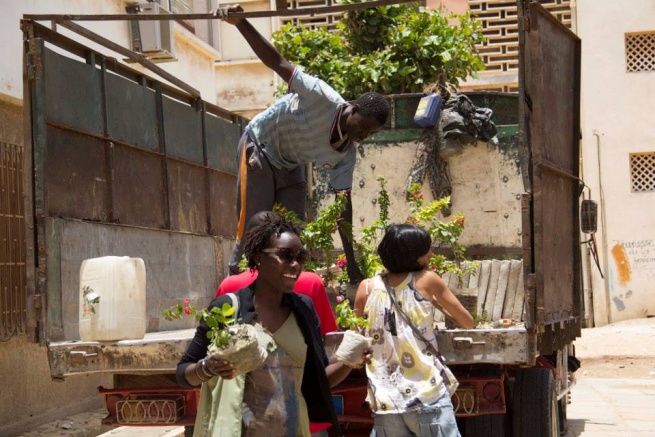
Jet d'Eau, Afropixel #4, 2014, Courtesy Kër Thiossane
L27: One of the main ideas at the basis of Afropixel4 was the invitation to “do the most possible with the least possible” (Gilles Clément), which has become a principle inspiring the practices of resistance against post-Ford Capitalism and its economic and environmental consequences. How were Clément’s thoughts translated into actions and projects within the specific context of Dakar and the festival?
ML: All the activities included in the Festival were based on Gilles Clément’s idea that it is necessary to safeguard common good and sobriety. Jerry Cane, for example, invited young people to build computers inside a container by using old computers to be discarded, thus subverting the obsolescence of electronic materials currently polluting the African continent. Resistance was also evoked or encouraged by other activities, such as the creation of the Jet d'Eau garden in an abandoned space of an old middle-class district in Dakar. The act of growing plants and creating a garden in such a city as Dakar is indeed an act of resistance. Nowadays, with commercial interests seriously affecting natural gifts such as water, air, soil, seeds, bees, etc., the creation of a garden is a political act. As Gilles Clément wrote in his essay Rêve en sept points pour une généralisation des jardins de résistance, a garden of resistance is an area, public or private, where the art of gardening is practiced in harmony with nature and man, free of market domination. Diversity, both biological and cultural, as well as the preservation of water, soil and air is encouraged for the common good.
L27: Can you tell us something about Jet d’Eau: what happened exactly, how was this urban area transformed, and why did you choose this public space?
ML: Sicap is one of the earliest middle-class districts in Dakar, built in the 1960s after independence. As some people recall, it was a chic, clean neighborhood, with green areas, a fountain (Jet d’Eau), buildings… After forty years, the district has become unhealthy and unsafe, and is left in a state of anarchy and individualism, with high rates of inactive and unemployed youth. We chose to establish the Commons School in this place, near the Jet d’Eau, because it is a hundred meters from Kër Thiossane and, even if it is a co-owned space, it is an area crossed by hundreds of people every day. Everybody uses it in his/her own way: as a public toilet, a dumping ground, a workshop, a playground, a crossing point… We also used it in the past to organize installations and public screenings for the festival. This public space seemed to us a true “common good” whose deterioration was upsetting everybody. The moment had come to join forces and do something together. Art was a suitable means. Regardless of the structure, this place will become a space for experimentation, an open-air workshop where the public will be involved both as an actor and spectator. Through a new configuration of the garden, a dialogue will be established with the neighbors, who are invited to participate in the project and in the activities carried out in this place. By re-arranging the public space and combining different research fields (design, contemporary art and architecture), this project questions the city of Dakar as it is transformed. The creation of an artistic garden in a public space located in the heart of the capital is the tangible proof that there is a true relationship between art and social change. In the long run, this experience will allow us to concretely explore the role of artists in society and their contribution to the sharing of common goods and the practice of living together.
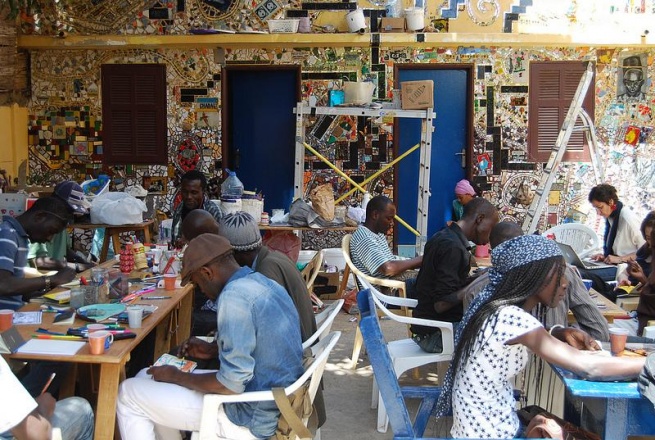 Workshop AtWork Dakar, Afropixel #3, 2014, Courtesy lettera27
Workshop AtWork Dakar, Afropixel #3, 2014, Courtesy lettera27
L27: What kind of relationship did you establish with the inhabitants of the neighborhood? What challenges did you face? Did you work together to create the garden? If so, what was the reaction of the local community before and after the project?
ML: The dialogue with the residents of the four buildings adjoining the area only started at the end of 2013, when we first met the main personalities of the neighborhood, such as the Imam of the Mosque and the representative of the association of landlords and tenants; then we met the youth association and, finally, we went from home to home to explain the project to everybody and have their approval for the creation of a garden in their co-owned space. A two-year contract was signed with the Mayor on behalf of those residents who had not settled their disputes and were not part of the association of landlords. It is a long-term project and, as the garden takes shape, the inhabitants seem to appreciate these first changes. Children are the ones who visit it more regularly, especially during the irrigation hours. Adults like the idea of an artistic garden, and often ask about its meaning. Since its creation, there has been an increasing awareness of the possibility to change things, and willingness to take action, but there is still much to do.
L27: Can you tell us about the École des Communs? What kind of activities are carried out, and what is the central idea connecting the various disciplines of the school: art, technology, urban ecology, economics, etc.? What will happen in the school in the next few months?
ML: The school is designed as an open space for interdisciplinary research and experimentation, intertwining art, technology, urban ecology, economics and good-neighbor practices. Through the projects and meetings proposed, art and culture can contribute to sustainable innovation, putting into practice the idea of open culture and the sharing of knowledge.
 Exhibition in the garden Jet d'Eau, 2014, Courtesy Kër Thiossane
Exhibition in the garden Jet d'Eau, 2014, Courtesy Kër Thiossane
L27: What about the Fablabs?
ML: The Fablab is called “Defko Ak Niep” and results from two years of reflection about the project “Rose des Vents Numeriques”. During this digital “spin-off” project in Africa and the Caribbean, through meetings and workshops, we started thinking about the establishment of Fablabs in Africa (particularly in Mali and Senegal), where a thousand-year-old artisan tradition plays a fundamental role in society, and DIY and recycling are daily practices for a vast number of people. In 2013 we organized some weekly workshops with electricians, computer experts, fabbers and craftsmen to create an extruder and a 3D printer. It was not easy because we were short of resources and highly qualified professionals. Moreover, it was not always possible for artisans to leave their jobs and dedicate themselves to other activities, and the “do-it-with-others” culture was not always appealing to Senegalese people. Nonetheless, it was a very positive experience, which allowed us to identify a network of people with very different backgrounds, but all driven by great creativity, ideas and good will. It was about time to bring them together! The idea of creating a Fablab came up spontaneously along with the École des Communs project, which was based on the promotion of artistic research, open culture and shared knowledge in the neighborhood. The international organization “La Francophonie” supported the project. Instead of using their contribution to purchase materials, we preferred to allocate part of the budget to organize a preliminary meeting with three experts who could help us develop the project. In December 2013, we invited Camille Bosqué (France), Claire Williams (Belgium) and Olivier Heinry (France) for a couple of weeks to meet local players and share their thoughts about the activities to be performed during the first year. We thought about workshops focusing on the most common activities and trades in the local community (textiles, sewing, carpentry, etc.) so as to provide participants with the opportunity to share skills and ideas. The Fablab kicked off in March 2014 with the workshop “Textile motif Remix”, which involved Claire Williams (Belgium), Fabien Cornut (France), Olivier Heinry (France) and Senegalese writer Ken Bugul. Focusing on all kinds of handwork – knitting, embroidery, natural dyeing, printing fabrics, silk screen and digital techniques – this pilot workshop turned the Fablab into a space for the production and circulation of knowledge, thanks to the intertwining of various skills (tailor, textile designer, artist, graphic designer, carpenter, dyer, chemist, developer, electrician). Some products (shoes, bags, embroidered clutch bags, etc.) were sold during Afropixel 2014. The sale proceeds were equally shared among the social center, the manufacturers and the Fablab, following the cooperative business model.
L27: How are you going to enhance the connection between the Fablab and the local community?
This is a new project, still in its early stages. We should not make the mistake of rushing things, following trends or adopting existing formats that do not fit our context. It takes time for a Fablab purposely established in the public space to involve different kinds of people: we cannot expect people to immediately understand what a Fablab is and what interests and issues are at stake.
Another challenge is to ensure the long-term survival of the Fablab by creating a closely-knit team and community and finding a viable business model. It is really important to involve local institutions such as the Ministries of Youth, Labor, Entrepreneurship, ICT and Economy and have their support to plan activities for young people in Dakar and Senegal.

